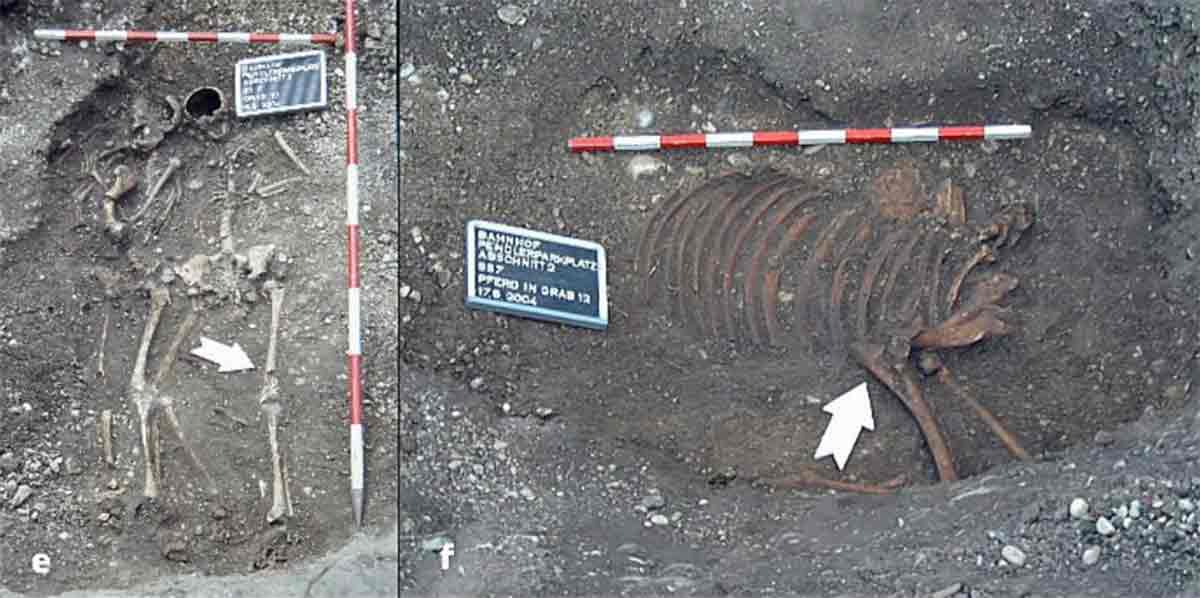Mistaken for Lovers, Roman-Era Grave Holds Mother and Daughter (and Horse…)
When found in 2004, two embracing skeletons buried arm in arm in what is now Austria, were believed to be lovers from medieval times. Instead, modern scientific techniques have now helped archaeologists understand that what they were looking at has been the first documented mother-daughter burial from the Roman era in Austria!
In fact, the graves predate by nearly 500 years, dating back to the 2nd or 3rd century AD. And, just to mix it up a bit, there’s a horse in there too.
Unearthing the Discovery and Changing the Narrative
Initially discovered in 2004 during construction activities near the eastern burial ground of the ancient Roman city of Ovilava, present-day Wels in Upper Austria, the purported medieval burial became the subject of a new study published by scientists from the University of Vienna. Their finds that date the burial to 1,800 years ago, have been recorded in The Journal of Archaeological Science.
- Late Viking Age Grave Imitating A Roman Age Grave, Not Just Allusion to Power
- 50 Roman Slaves Found Buried with ‘Care’ in England

The arrangement of the mother and daughter prompted an initial assessment that the grave held lovers (D Hagmann et al / Science Direct)
Archaeologists unearthed three sets of skeletal remains: two humans and one horse. Accompanying them are two beautiful golden pendants shaped like a wheel and a crescent moon. One individual's right arm was draped around the other's shoulder, pointing to a profound social and emotional bond between them.
Initially, the burial had been tentatively identified as Bavarian, dating from the 6th to 7th centuries AD. This classification was based on several factors: the depth of the grave, its west-east orientation (a common feature in Bavarian burials), and historical records indicating the presence of Germanic Bavarians in the region during the early seventh century, according to a press release.
For the purposes of the study, researchers conducted a thorough re-examination of the remains utilizing osteological investigations, radiocarbon dating, ancient DNA analysis, and visual inspection. Their findings revealed that the bones belonged to individuals aged between 20 to 25 years old and 40 to 60 years old, indicating they lived around 200 AD, when the region was part of the Roman Empire.

Celtic familial graves are well known, both in the Roman-era and beyond (D Hagmann et al / Science Direct)
In a surprising turn, both human skeletons were identified as female through anatomical analysis. Subsequent DNA analysis confirmed their biological female status and revealed that they were first-degree relatives, suggesting they were either sisters or a mother and daughter pair. Numerous scientists not involved with the study point to the latter, particularly in light of the apparent 15-20 year gap between the two bodies.
"It's the first genetically proven mother-daughter burial in Austria in Roman times," study senior author Sylvia Kirchengast, a professor of evolutionary anthropology at the University of Vienna, told Live Science. "We also disprove a long-held misconception about the kind of relation between the two individuals."
Non-Roman Elites: Could they be Celts?
The presence of a horse and gold pendants strongly suggests that the women held high social status and were likely non-Roman elites. According to Dominik Hagmann, the lead author of the study and an archaeologist at the University of Vienna, it is exceedingly rare for Roman individuals to be buried with horses, as they were not considered a 'horse-people'.
He theorized that these two individuals likely belonged to a Celtic culture that persisted during Roman times. The Celts were known to frequently bury horses alongside their owners in high-status burials.
“The exact background of the double burial is not clear. The scientists theorize that both may have died of an illness at the same time and, according to a tradition from the late Iron Age, buried with their horse. The older person has skeletal features that could indicate frequent riding. Ultimately, this study shows the enormous potential that the use of modern, scientific methods in combination with traditional research approaches for archeology in Roman Austria offers”, concludes the press release.
Top image: Mother, Daughter and horse too: the occupants of the Roman-era grave are not lovers, after all. Source: D Hagmann et al / Science Direct.
By Sahir Pandey
References
Fraga, K. 2024. An Ancient Roman Burial Of An Embracing Mother And Daughter Has Been Uncovered In Austria. Available at: https://allthatsinteresting.com/austria-roman-burial
Hagmann, D., Ankerl, B. et al. 2024. Double feature: First genetic evidence of a mother-daughter double burial in Roman period Austria. Journal of Archaeological Science: Reports, 55. Available at: https://doi.org/10.1016/j.jasrep.2024.104479
Kayra, O. 2024. The first mother-daughter burial from the Roman period found in Austria. Available at: https://arkeonews.net/the-first-mother-daughter-burial-from-the-roman-period-found-in-austria/
Sagar, S. 2024. Roman-era skeletons buried in embrace, on top of a horse, weren't lovers, DNA analysis shows. Available at: https://www.livescience.com/archaeology/roman-era-skeletons-buried-in-embrace-on-top-of-a-horse-werent-lovers-dna-analysis-shows
















